Abstract
Oral mucosal melanoma is a relatively rare malignancy with an aggressive clinico-pathological behaviour. The mean 5-year survival rate is about 15 %. It arises primarily from melanocytes found in the basal cell layer of the epithelium, but may sometimes arise from melanocytes residing in the lamina propria. The pathogenesis is complex, and few of the molecular mechanisms underlying the development of oral mucosal melanoma have been defined. The extraneous risk factors associated with oral mucosal melanoma, if any, are unknown. Oral mucosal melanomas account for about 25 % of all mucosal melanomas of the head and neck, and exhibit a profile of cytogenetic alterations, and a pathobiological behaviour and clinical course different from that of cutaneous melanomas. As they are usually painless and grow quickly, as a rule, they are diagnosed late in the course of the disease when the lesions are already large and have metastasized to regional lymph nodes. In this paper we discuss some aspects of the pathobiology of oral mucosal melanoma, and present an illustrative case report.
Keywords: Oral melanoma, Melanocyte stem cells, Pathobiology of melanocytes
Introduction
Both cutaneous and mucosal melanomas arise from atypical melanocytes which have acquired a malignant phenotype. Mucosal melanomas are relatively rare malignancies with an aggressive clinico-pathological behaviour and a poor prognosis, affecting the upper aerodigestive tract (mouth, pharynx, larynx, nasal cavity, paranasal sinuses, salivary glands), the genito-urinary tract, or the anorectal region [1]. Mucosal melanomas are distinct from cutaneous melanomas in several respects: they arise at sites that are not exposed to solar radiation, they exhibit a different profile of cytogenetic alterations, and they are different in their pathobiological behaviour and clinical course [2–4]. Mucosal melanomas account for about 1.3 % of all melanomas [5, 6].
Approximately 55 % of all mucosal melanomas are located in the head and neck [5]; about 70 % of mucosal melanomas of the head and neck affect the nasal cavity and paranasal sinuses, while about 25 % affect the oral mucosa [1, 7]. Oral mucosal melanomas account for between 0.26 and 0.5 % of all oral malignancies [8, 9], and for unknown reasons their incidence and prevalence are higher in Asia than in North America or Europe [9]. Their incidence and prevalence in Africa are unknown. Mucosal melanoma does not appear to be associated with any known carcinogenic agent [4].
Oral mucosal melanomas commonly arise de novo, but up to one-third of cases are said to arise from benign melanotic oral lesions [8, 10]. The palate and the maxillary gingiva of elderly men are most frequently affected [8, 11–15]. Oral mucosal melanomas are usually painless and grow rapidly, so they are often diagnosed late in the course of the disease when the lesions are already large and have metastasized to regional lymph nodes. Up to 36 % of subjects with oral mucosal melanomas will have cervical lymphadenopathy at the time of diagnosis; and in about 85 % of cases, early in the course of the disease, the melanoma will metastasize to the liver, lung, bone or brain by direct haematogenous dissemination [11, 16, 17].
We present a case of an advanced oral mucosal melanoma in a 56-year-old black female in whom, at the time of diagnosis, there had already been metastasis to the regional lymph nodes, lung, liver and brain.
Case Report
A 56-year-old black female was referred to the Oral and Maxillofacial outpatient clinic at Medunsa Oral Health Centre with pigmented lesions of the hard palate and maxillary gingiva (Figs. 1, 2, 3). She reported that 3 years previously she had noticed a small painless pigmented macule on the gingiva labial to the maxillary left central incisor. At that time, her local dentist had assured her that there was nothing to worry about. However, about a year later, the gingival lesion started to enlarge, and she noticed new similar lesions on her palate, which were also enlarging. The lesions were still painless.
Fig. 1.
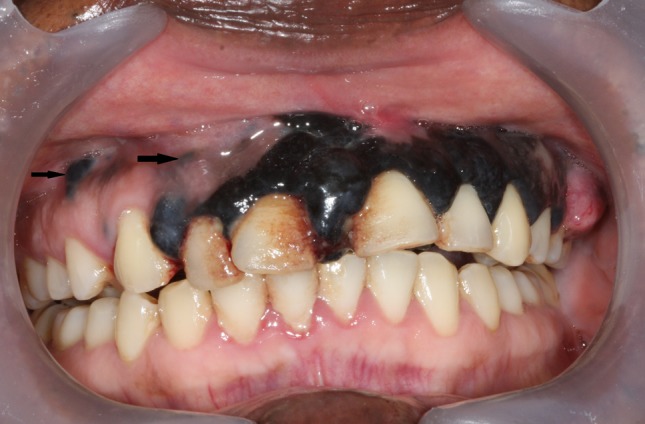
Melanoma of the maxillary labial gingiva and alveolar mucosa
Fig. 2.
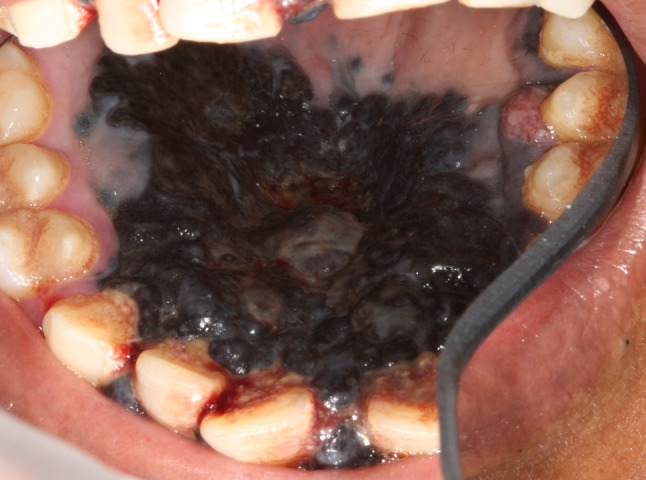
Melanoma of the hard palate
Fig. 3.
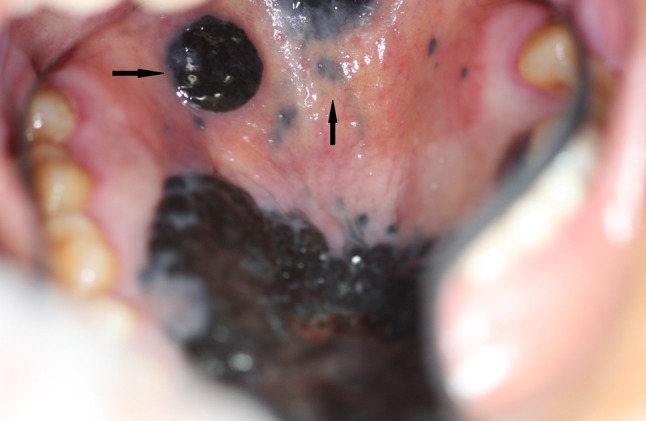
Multifocal melanoma of the posterior hard and soft palate
About 3 weeks before our consultation, she became worried about the lesions because of their size and appearance. She then consulted a medical practitioner who referred her to our clinic. On examination, extensive black pigmentation of the labial gingiva, and separate macular, papular and plaque-like black pigmented lesions of the adjacent alveolar mucosa were observed (Fig. 1). The anterior labial gingival pigmentation extended interdentally, and became continuous with an even larger area of confluent black pigmented lesions of the palate (Fig. 2). In the more posterior part of the palate, there were several similar but smaller pigmented lesions (Fig. 3). There was extensive cervical and submandibular lymphadenopathy.
Radiographically, the large masses of matted regional lymph nodes were apparent (Fig. 4), and there was widespread metastasis to the lungs (Fig. 5), liver, bones and brain. Two biopsies from the gingival and the palatal lesions confirmed the diagnosis of malignant melanoma.
Fig. 4.
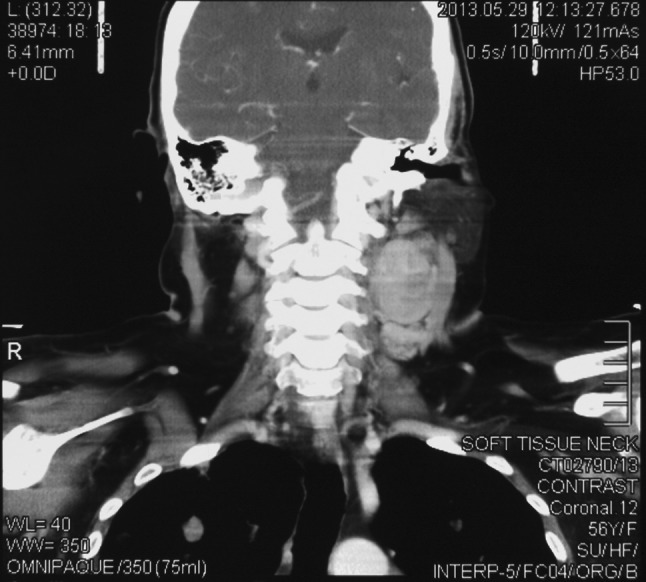
A coronal CT scan of the head and neck showing large matted lymph nodes on the left side displacing the parotid upwards
Fig. 5.
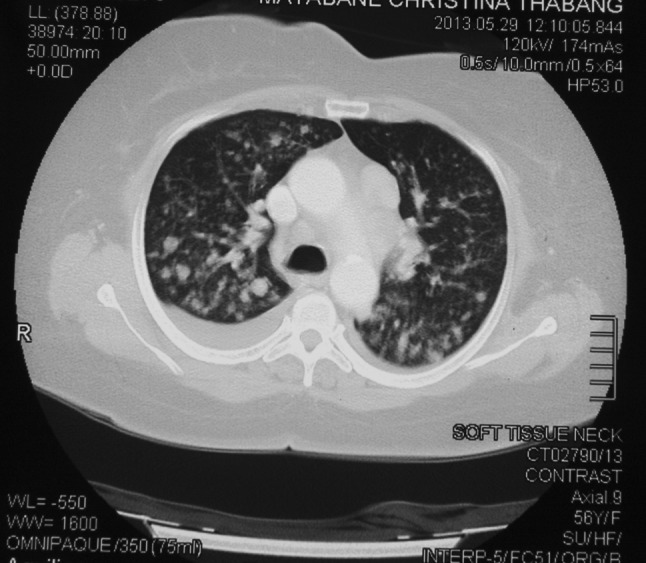
An axial CT scan of the thorax showing large para-aortic lymph nodes at the aortic knuckle. The numerous scattered radiopacities are presumed to be melanotic metastasis of the lung
Microscopic examination of the gingival biopsy showed a nodular tumour situated in the reticular part of the lamina propria and extending into the submucosal tissues to the depth of the biopsy (Fig. 6a, b). The nodule was poorly circumscribed and consisted of a sheet of both epithelioid and spindle shaped pleomorphic cells (Figs. 7, 8). The nuclei were pleomorphic and hyperchromatic and contained one or more amphophilic nucleoli (Figs. 7, 8). Numerous abnormal mitotic figures were evident (Fig. 8). The melanocytes in the overlying epithelium showed no evidence of junctional activity, of lentiginous hyperplasia or of Pagetoid spread, and the basement membrane was intact (Fig. 6a, b). In the biopsy of the palatal nodule, essentially similar histological features were seen, except that the tumour was located deep in the submucosa suggesting a focus of localised spread. No evidence of any lymphocytic infiltration, of tumour necrosis, of lympho-vascular invasion or of perineural growth was evident. In the palatal lesion the surface was ulcerated (Fig. 7). There was abundant production of melanin pigment which in parts was so dense that the morphology of the tumour cells was obscured (Fig. 6a). In the presence of adequate controls, immunohistochemical staining for S100, Melan A, HMB45 and MITF was strongly and diffusely positive. Immunohistochemical staining for c-kit, EMA, MNF116, p16, p53 and CEA was negative (Fig. 9a–d).
Fig. 6.
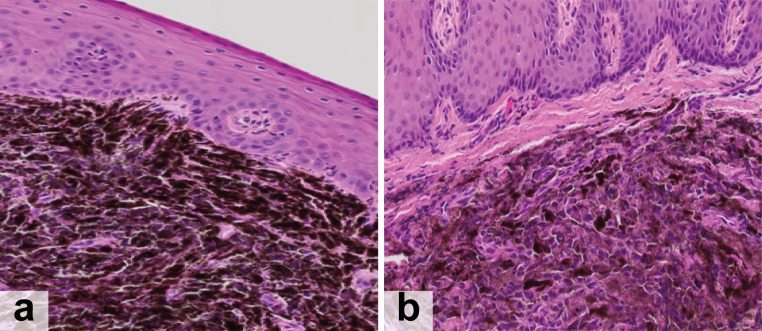
a and b The nodular tumour was uncircumscribed consisting of a sheet of heavily pigmented cells. The overlying epithelium showed no evidence of abnormal numbers or activity of the resident melanocytes (a haematoxylin and eosin ×40, b haematoxylin and eosin ×40)
Fig. 7.
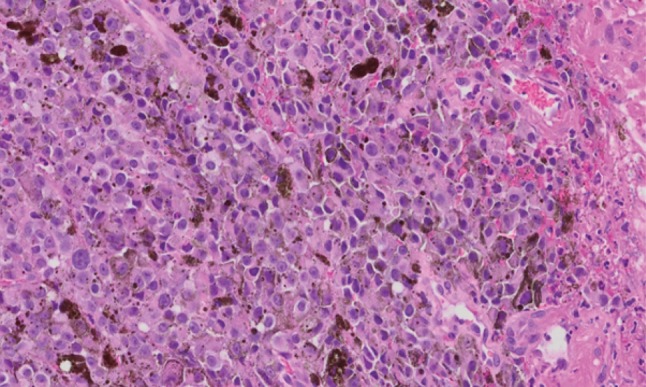
The tumour consisted of sheets of pleomorphic epithelioid and spindle shaped cells. There is abundant intra- and extra-cellular melanin (haematoxylin and eosin ×150)
Fig. 8.
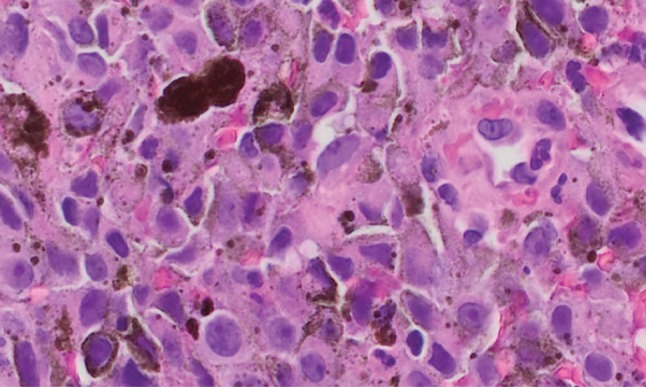
The cells and nuclei were markedly pleomorphic and the nucleoli were amphophilic and varied in number and in size. Numerous mitoses could be discerned (haematoxylin and eosin ×400)
Fig. 9.
Immunohistochemical staining. The brown pigment is melanin. A red chromogen was used. a Positive nuclear staining, MITF ×400, b positive staining of both nuclei and cytoplasm, S-100 ×300, c positive membrane and cytoplasmic staining, HMB 45 ×400, d negative staining, c-kit ×400
As there was no histological evidence that the melanoma had arisen from melanocytes residing in the oral epithelium, the possibility that it was a metastatic tumour was considered, but was rejected on the grounds that careful clinical evaluation disclosed no primary melanoma elsewhere.
The patient was referred to the Department of Oncology for further management, but she died before treatment started.
Discussion
Melanocytes are derived from neural crest precursor cells which, during development, migrate from the neural crest, enter the dorsolateral pathway, and ultimately differentiate into melanocytes that will reside in the skin and in various mucous membranes [12, 18–20]. The migration of melanocyte precursor cells from the neural crest, and their differentiation into mature melanocytes is mediated by complex interactions between transcription factors expressed during embryogenesis, including Snail2 (slug), Sox10, Sox9, FoxD3; by intracellular signalling pathways including tyrosine kinase receptor, c-kit/stem cell factor, endothelin receptor type B/endothelin [19–21], Wnt/β-catenin [5, 18, 22] and Notch/RBP-J [18, 23]. In the oral mucosa, melanocytes normally reside in the basal and suprabasal cell layers of the epithelium but occasionally neural crest cells, destined to become melanocytes of the epithelium, remain entrapped in the submucosa [24].
Both cutaneous and mucosal melanomas are derived from neural crest cells, and so belong to the family of neural crest dysmorphologies classified as neurocristopathies [25]. Tissue-specific melanocyte stem/progenitor cells are relatively undifferentiated, divide infrequently, and have the capacity for self-renewal. Therefore, as component cells of the epithelium they maintain their integrity, genetic information and regenerative capacity. Melanocyte stem/progenitor cells have been identified in human skin, either in the dermal papillae or in the epidermal bulge area of hair follicles [18, 19, 21, 23, 26]; they may also persist in sheaths of superficial nerves after embryogenesis [27]. Replacement of melanocytes lost to mechanical, thermal or chemical injury, or as a result of depletion by the natural process of apoptosis, occurs by migration into the epidermis of melanocyte stem cells from the above mentioned niche reservoirs. After migration, these melanocyte stem/progenitor cells differentiate into mature melanocytes thus contributing to the maintenance of epidermal homeostasis [27].
However, the mechanism whereby melanocytes or their precursors are able to migrate through formed basement membranes and between keratinocytes/epithelial cells to maintain the population of melanocytes of skin or mucosa is not well understood. In an in vitro study utilising HaCAT keratinocytes [28], it has however been shown that melanocytes not only exhibit a malleability and “fluidity” which allows them to pass through very small spaces in order to enter the epithelial compartment, but that the melanocytes also regulate adhesion molecules, such as laminins and integrins on their processes in order to do so. To the best of our knowledge, no mechanism for maintenance or replacement of oral mucosal melanocytes has been identified, though such mechanisms must exist because the population of melanocytes is maintained in a steady state under physiological conditions.
Apart from the critical role of melanocytes in producing melanin which protects sun-exposed skin from the damaging effects of UV radiation [29], it appears that melanocytes also act as neuroendocrine cells, producing l-Dopa and l-tyrosine which are intermediaries in the melanin biosynthesis pathway. Melanocytes also have the capacity to produce melatonin and serotonin which appear to contribute to the regulation of the metabolic activities of neighbouring cells and thus to the homeostasis of skin and mucosa both under physiological conditions, and in response to noxious stimuli [30]. The functions of mucosal melanocytes in this regard are not well understood [12, 31, 32].
α-Melanocyte stimulating hormone (α-MSH), adrenocorticotrophic hormone (ACTH), β-endorphin, prostaglandins, leukotrienes, endothelin-1 (ET1) and endothelin-3 (ET3), histamine, stem cell factor (SCF), oestrogens, androgens, vitamin D3 and bone morphogenic proteins (BMPs) are soluble agents that are either produced locally or have reached the mucosal microenvironment via the circulation, and have the capacity to stimulate biosynthesis of melanin. On the other hand, melatonin, IL-1, IL-6, TNF-α, TGF-β, IFNγ and glucocorticoids in the local microenvironment are inhibitors of melanogenesis [33]. The production of melanin is therefore regulated by complex interactions between stimulating and inhibiting biological mediators [30, 33, 34].
It is evident that the process of biosynthesis of melanin by melanocytes, if not regulated, has the capacity to generate oxidative stresses, and metabolic by-products that may be cytotoxic, genotoxic or mutagenic, causing DNA damage to the affected melanocytes, thus favouring initial cell transformation, and later, promoting the progression to cancer of initially transformed melanocytes [35]. The intermediate metabolites of melanogenesis released into the microenvironment have immunosuppressive properties that may contribute to evasion of immune responses by the initially transformed, and by malignant melanocytes. Excessive physical (solar) stimulation of melanocytes or chemical stimulation by agents mentioned above in connection with biosynthesis of melanin may bring about an increase in their rate of proliferation, and in their production of melanin. This in turn favours initial transformation of normal melanocytes, and further transformation of precancerous melanocytes into malignant melanoma cells [13, 35].
It is probable that most melanoma precursor cells originate as stem/progenitor melanocytes that may already have acquired epigenetic and/or cytogenetic alterations to their oncogenes, to their tumour-suppressor genes and to their DNA repair genes, and consequently, have acquired a malignant phenotype [10, 21, 22, 36–38]. The precursor melanoma cells are probably analogues of melanocyte stem/progenitor cells that express dysregulated developmental transcription factors [11, 18, 19, 21, 39]. Alternatively, precursor melanoma cells may originate as mature melanocytes residing either in the basal cell layer of the epithelium or in the submucosa, that have undergone cytogenetic alterations culminating in de-differentiation [19, 26]. These melanoma precursor cells have an extended self-renewal capacity, that sustains the growth of the melanoma, as their constant replication provides new atypical transient-amplifying melanocytes with extended proliferative capacity and prolonged survival [22, 23, 35, 40].
The atypical transformed melanocytes express abnormalities in the c-kit/stem cell factor pathway, in the endothelin receptor type B/endothelin pathway, and in the Wnt/β-catenin pathway, and also show abnormal expression of cell-adhesion molecules [5, 14, 18, 22, 41, 42]. Together, these molecular lesions selectively confer upon the atypical transformed melanocytes a competitive advantage in terms of their fitness and growth in relation to the neighbouring normal cells. Clonal expansion with subsequent clonal divergence results in the evolution of subclones of mucosal melanoma cells with multiple genetic alterations constituting a cancerous phenotype [19, 35]. These clonally expanded melanoma cells have the capacity for deep invasion and tissue destruction, for metastasis to regional lymph nodes, and for haematogenous metastasis to distant sites including the liver, lungs, bone and brain [35, 39, 43].
Clinically, oral mucosal melanomas are irregularly shaped and are not uniform in colour, varying in pigment distribution giving rise to shades of black, dark blue, grey or brown. The lesions are either macular, nodular, plaque-like or a combination of these forms [44]. Early oral mucosal melanomas are usually asymptomatic, but advanced mucosal melanomas may show areas of superficial ulceration that bleed [11, 12].
The histopathological features of oral mucosal melanoma arising from melanocytes residing in the oral epithelium are variable. Three patterns are recognised: an in situ pattern in which the neoplasm is restricted to the epithelial-connective tissue interface, a deeply invasive or nodular pattern, and a combined lesion in which a nodular component occurs together with an in situ or with a radially growing pattern [10, 44, 45].
The phase of radial growth is characterized by proliferation of atypical melanocytes within the oral epithelium, and by small breaches of the basement membrane with nests of invading cells, and with a reactive inflammatory cell infiltrate in the superficial part of the lamina propria [8, 44, 45]. Complete excision of a melanoma in its radially growing phase, before it starts to invade deeply, is usually associated with a relatively favourable clinical outcome [17]. Once the basement membrane is breached, the melanoma starts to invade the submucosa, characteristically in nodular aggregates of infiltrating monoclonal melanoma cells that have the capacity to metastasize. Treatment in this phase generally has a much less favourable clinical outcome. Nodular melanoma can develop without any significant preceding phase of radial growth [44, 45].
In contrast to those patterns of melanoma which arise from melanocytes residing in the oral epithelium, a melanoma may also originate from melanocyte precursors residing in the submucosa as a result of arrest in their migration from the neural crest. In such a case the melanoma would not be expected to show any evidence of having arisen from intraepithelial melanocytes which had breached the basement membrane. In our patient, the melanoma was located in the submucosa without any apparent breach of the basal lamina of the overlying epithelium and thus had evidently arisen from such arrested melanocytes. The fact that the tumour cells in our case were indeed of melanocytic origin was confirmed by immunohistochemical positivity for S-100, melan-A (MART-1), HMB45 and MITF [46]. However, as the oral mucosal melanoma in our case was extensive, and as the histopathological examination was limited to two incisional biopsies, we cannot exclude the possibility that there was a junctional component that was not biopsied.
Pre-existing oral melanotic lesions have occasionally been reported to give rise to oral mucosal melanoma; but no extraneous aetiological factors have been convincingly linked either to de novo development of oral mucosal melanoma, or to the transformation of benign melanotic lesions to oral mucosal melanoma [4]. It was impossible in our case to determine whether the oral mucosal melanoma had arose from pre-existing melanotic pigmentation, but the fatal outcome of the patient was undoubtly owing to failure to diagnose and treat in good time.
Oral mucosal melanomas may be multifocal, and have a high rate of recurrence at the sites of apparently completely excised melanomas, or new primary melanomas may arise at sites nearby the original primary melanoma. Therefore, as in the case of oral carcinoma, it is reasonable to assume that oral mucosal melanomas develop within epithelial fields harbouring multiple melanocytes that have undergone initial premalignant transformation. Upon acquisition of additional cytogenetic alterations, these precancerized melanocytes can acquire a malignant phenotype that gives rise to a melanoma [3, 11, 39, 44]. Gain-of-function mutations or gene amplifications and overexpression of c-kit have been found in up to 40 % of cases of mucosal and acral melanomas, but are uncommon in cutaneous melanoma. On the other hand, BRAF and N-RAS mutations have been found in up to 50 % of cutaneous melanomas but are uncommon in mucosal and acral melanoma [3, 4, 36]. This indicates that there may be differences in molecular tumorigenic pathways of mucosal and cutaneous melanomas.
Mucosal melanomas in general behave more aggressively and have a worse prognosis than their cutaneous counterparts, maybe because, being painless in the earlier stages and being hidden in the upper aerodigestive tract or in the anogenital area, mucosal melanomas are often diagnosed only late when they are at an advanced stage. Reportedly, the 5 year survival rate of oral mucosal melanoma is poor, at 12–16 %, with an estimated mean survival time of 2 years [6, 12]. The larger the melanoma and the deeper its invasive front, the poorer the prognosis will be [3, 6, 9, 46]. Other factors associated with poor prognosis are a high mitotic rate of the atypical melanocytes, vascular or neural invasion, loss of expression of p16 protein, and aberrant expression of p53 protein [46, 47]. Altered expression of cell-adhesion molecules, particularly loss of expression of E-cadherin, upregulation of N-cadherin, and reduced expression of β-catenin are associated with tumour growth and metastasis [14].
Summary
Oral mucosal melanoma is an aggressive tumour most frequently affecting the palate and the maxillary gingiva, and is usually painless and grows quickly so that it is often diagnosed late in the course of the disease when the lesions are already large and have metastasized to regional lymph nodes. The chain of molecular events that bring about malignant transformation of melanocytes giving rise to oral mucosal melanoma is unknown.
Acknowledgments
We would like to thank Professor B. Kramer for her intellectual input and constructive comments.
Conflict of interest
The authors declare that they have no competing interests.
Contributor Information
M. M. Tlholoe, Email: Martha.Tlholoe@ul.ac.za
R. A. G. Khammissa, Email: Razia.khammissa@ul.ac.za
M. Bouckaert, Email: Michael.bouckaert@ul.ac.za
M. Altini, Email: Altini@iafrica.com
J. Lemmer, Email: jbowman@iburst.co.za
L. Feller, Email: liviu.feller@ul.ac.za
References
- 1.Pfister DG, Ang KK, Brizel DM, et al. Mucosal melanoma of the head and neck. JNCCN: J Natl Compr Cancer Netw. 2012;10:320–338. doi: 10.6004/jnccn.2012.0033. [DOI] [PubMed] [Google Scholar]
- 2.Curtin JA, Fridlyand J, Kageshita T, et al. Distinct sets of genetic alterations in melanoma. N Engl J Med. 2005;353:2135–2147. doi: 10.1056/NEJMoa050092. [DOI] [PubMed] [Google Scholar]
- 3.Postow MA, Hamid O, Carvajal RD. Mucosal melanoma: pathogenesis, clinical behavior, and management. Curr Oncol Rep. 2012;14:441–448. doi: 10.1007/s11912-012-0244-x. [DOI] [PubMed] [Google Scholar]
- 4.Furney SJ, Turajlic S, Stamp G, et al. Genome sequencing of mucosal melanomas reveals that they are driven by distinct mechanisms from cutaneous melanoma. J Pathol. 2013;230:261–269. doi: 10.1002/path.4204. [DOI] [PubMed] [Google Scholar]
- 5.Wei C, Sirikanjanapong S, Lieberman S, et al. Primary mucosal melanoma arising from the eustachian tube with CTLA-4, IL-17A, IL-17C, and IL-17E upregulation. Ear Nose Throat J. 2013;92:36–40. doi: 10.1177/014556131309200112. [DOI] [PMC free article] [PubMed] [Google Scholar]
- 6.Papaspyrou G, Garbe C, Schadendorf D, et al. Mucosal melanomas of the head and neck: new aspects of the clinical outcome, molecular pathology, and treatment with c-kit inhibitors. Melanoma Res. 2011;21:475–482. doi: 10.1097/CMR.0b013e32834b58cf. [DOI] [PubMed] [Google Scholar]
- 7.Kottschade LA, Grotz TE, Dronca RS, et al. Rare presentations of primary melanoma and special populations: a systematic review. Am J Clin Oncol. 2013. doi:10.1097/COC.0b013e3182868e82. [DOI] [PMC free article] [PubMed]
- 8.Lourenco SV, Bologna SB, Hsieh R, et al. Establishment and characterization of an oral mucosal melanoma cell line (MEMO) derived from a longstanding primary oral melanoma. Am J Dermatopathol. 2013;35:248–251. doi: 10.1097/DAD.0b013e31826a9905. [DOI] [PubMed] [Google Scholar]
- 9.Wang X, Wu HM, Ren GX, et al. Primary oral mucosal melanoma: advocate a wait-and-see policy in the clinically N0 patient. J Oral Maxillofac Surg. 2012;70:1192–1198. doi: 10.1016/j.joms.2011.03.036. [DOI] [PubMed] [Google Scholar]
- 10.Mohan M, Sukhadia VY, Pai D, et al. Oral malignant melanoma: systematic review of literature and report of two cases. Oral Surg Oral Med Oral Pathol Oral Radiol. 2013;116:e247–e254. doi: 10.1016/j.oooo.2011.11.034. [DOI] [PubMed] [Google Scholar]
- 11.Feller L, Masipa JN, Wood NH, et al. Primary oral melanoma associated with HIV infection. SADJ J S Afr Dent Assoc = tydskrif van die Suid-Afrikaanse Tandheelkundige Vereniging. 2008;63:016–017. [PubMed] [Google Scholar]
- 12.Mihajlovic M, Vlajkovic S, Jovanovic P, et al. Primary mucosal melanomas: a comprehensive review. Int J Clin Exp Pathol. 2012;5:739–753. [PMC free article] [PubMed] [Google Scholar]
- 13.Gondivkar SM, Indurkar A, Degwekar S, et al. Primary oral malignant melanoma–a case report and review of the literature. Quintessence Int. 2009;40:41–46. doi: 10.3290/j.qi.a14113. [DOI] [PubMed] [Google Scholar]
- 14.Lucchese A, Favia G, Maiorano E, et al. Oral malignant melanoma: immunopathological analysis of a multiphasic case. Clin Exp Dermatol. 2010;35:789–791. doi: 10.1111/j.1365-2230.2010.03801.x. [DOI] [PubMed] [Google Scholar]
- 15.Shen ZY, Liu W, Bao ZX, et al. Oral melanotic macule and primary oral malignant melanoma: epidemiology, location involved, and clinical implications. Oral Surg Oral Med Oral Pathol Oral Radiol Endod. 2011;112:e21–e25. doi: 10.1016/j.tripleo.2011.02.040. [DOI] [PubMed] [Google Scholar]
- 16.Shibuya H, Takeda M, Matsumoto S, et al. The efficacy of radiation therapy for a malignant melanoma in the mucosa of the upper jaw: an analytic study. Int J Radiat Oncol Biol Phys. 1993;25:35–59. doi: 10.1016/0360-3016(93)90142-I. [DOI] [PubMed] [Google Scholar]
- 17.White RM, Zon LI. Melanocytes in development, regeneration, and cancer. Cell Stem Cell. 2008;3:242–252. doi: 10.1016/j.stem.2008.08.005. [DOI] [PubMed] [Google Scholar]
- 18.Grichnik JM. Melanoma, nevogenesis, and stem cell biology. J Invest Dermatol. 2008;128:2365–2380. doi: 10.1038/jid.2008.166. [DOI] [PubMed] [Google Scholar]
- 19.Sober AJ, Tsao H, Washington CV. Cancer of the skin. In: Fauci AS, Braunwald E, Kasper DL, Hauser SL, Longo DL, Jameson LJ, Loscalzo J, editors. Harrisons principles of internal medicine. 17. London: McGraw Hill Medical; 2008. pp. 541–545. [Google Scholar]
- 20.Real C, Glavieux-Pardanaud C, Le Douarin NM, et al. Clonally cultured differentiated pigment cells can dedifferentiate and generate multipotent progenitors with self-renewing potential. Dev Biol. 2006;300:656–669. doi: 10.1016/j.ydbio.2006.09.032. [DOI] [PubMed] [Google Scholar]
- 21.Carcoforo P, Raiji MT, Palini GM, et al. Primary anorectal melanoma: an update. J Cancer. 2012;3:449–453. doi: 10.7150/jca.5187. [DOI] [PMC free article] [PubMed] [Google Scholar]
- 22.Aubin-Houzelstein G, Djian-Zaouche J, Bernex F, et al. Melanoblasts’ proper location and timed differentiation depend on Notch/RBP-J signaling in postnatal hair follicles. J Invest Dermatol. 2008;128:2686–2695. doi: 10.1038/jid.2008.120. [DOI] [PubMed] [Google Scholar]
- 23.Shah KV, Chien AJ, Yee C, et al. CTLA-4 is a direct target of Wnt/beta-catenin signaling and is expressed in human melanoma tumors. J Invest Dermatol. 2008;128:2870–2879. doi: 10.1038/jid.2008.170. [DOI] [PMC free article] [PubMed] [Google Scholar]
- 24.Boland RP. The neurocristopathies: a unifying concept of disease arising in neural crest maldevelopment. Hum Pathol. 1974;5:409–429. doi: 10.1016/S0046-8177(74)80021-3. [DOI] [PubMed] [Google Scholar]
- 25.Dupin E, Calloni G, Real C, et al. Neural crest progenitors and stem cells. CR Biol. 2007;330:521–529. doi: 10.1016/j.crvi.2007.04.004. [DOI] [PubMed] [Google Scholar]
- 26.Cramer SF. Stem cells for epidermal melanocytes–a challenge for students of dermatopathology. Am J Dermatopathol. 2009;31:331–341. doi: 10.1097/DAD.0b013e31819cd0cb. [DOI] [PubMed] [Google Scholar]
- 27.Keswel D, Davids LM, Kidson SH. Migration of human melanocytes into keratinocyte monolayers in vitro. J Dermatol Sci. 2012;66:160–163. doi: 10.1016/j.jdermsci.2012.01.005. [DOI] [PubMed] [Google Scholar]
- 28.Barrett AW, Scully C. Human oral mucosal melanocytes: a review. J Oral Pathol Med. 1994;23:97–103. doi: 10.1111/j.1600-0714.1994.tb01095.x. [DOI] [PubMed] [Google Scholar]
- 29.Wood NH, Khammissa R, Meyerov R, et al. Actinic cheilitis: a case report and a review of the literature. Eur J Dent. 2011;5:101–106. [PMC free article] [PubMed] [Google Scholar]
- 30.Slominski A, Zbytek B, Slominski R. Inhibitors of melanogenesis increase toxicity of cyclophosphamide and lymphocytes against melanoma cells. Int J Cancer. 2009;124:1470–1477. doi: 10.1002/ijc.24005. [DOI] [PMC free article] [PubMed] [Google Scholar]
- 31.Mackintosh JA. The antimicrobial properties of melanocytes, melanosomes and melanin and the evolution of black skin. J Theor Biol. 2001;211:101–113. doi: 10.1006/jtbi.2001.2331. [DOI] [PubMed] [Google Scholar]
- 32.Plonka PM, Passeron T, Brenner M, et al. What are melanocytes really doing all day long…? Exp Dermatol. 2009;18:799–819. doi: 10.1111/j.1600-0625.2009.00912.x. [DOI] [PMC free article] [PubMed] [Google Scholar]
- 33.Slominski A, Wortsman J, Plonka PM, et al. Hair follicle pigmentation. J Invest Dermatol. 2005;124:13–21. doi: 10.1111/j.0022-202X.2004.23528.x. [DOI] [PMC free article] [PubMed] [Google Scholar]
- 34.Slominski A. Neuroendocrine activity of the melanocyte. Exp Dermatol. 2009;18:760–763. doi: 10.1111/j.1600-0625.2009.00892.x. [DOI] [PMC free article] [PubMed] [Google Scholar]
- 35.Carlson JA, Murphy M, Slominski A, et al. Evidence of skin field cancerization. In: Dakubo GD, et al., editors. Field cancerization: basic science and clinical applications. Ontario: Nova Science Publishers; 2011. pp. 317–370. [Google Scholar]
- 36.Bandarchi B, Jabbari CA, Vedadi A, et al. Molecular biology of normal melanocytes and melanoma cells. J Clin Pathol. 2013;66:644–648. doi: 10.1136/jclinpath-2013-201471. [DOI] [PubMed] [Google Scholar]
- 37.Hsieh R, Nico MM, Coutinho-Camillo CM, et al. The CDKN2A and MAP kinase pathways: molecular roads to primary oral mucosal melanoma. Am J Dermatopathol. 2013;35:167–175. doi: 10.1097/DAD.0b013e31825fa1f6. [DOI] [PubMed] [Google Scholar]
- 38.Vikey AK, Vikey D. Primary malignant melanoma, of head and neck: a comprehensive review of literature. Oral Oncol. 2012;48:399–403. doi: 10.1016/j.oraloncology.2011.12.014. [DOI] [PubMed] [Google Scholar]
- 39.Wang E, Voiculescu S, Le Poole IC, et al. Clonal persistence and evolution during a decade of recurrent melanoma. J Investig Dermatol. 2006;126:1372–1377. doi: 10.1038/sj.jid.5700193. [DOI] [PubMed] [Google Scholar]
- 40.Schatton T, Murphy GF, Frank NY, et al. Identification of cells initiating human melanomas. Nature. 2008;451:345–349. doi: 10.1038/nature06489. [DOI] [PMC free article] [PubMed] [Google Scholar]
- 41.Bologna SB, Nico MM, Hsieh R, et al. Adhesion molecules in primary oral mucosal melanoma: study of claudins, integrins and immunoglobulins in a series of 35 cases. Am J Dermatopathol. 2013;35:541–554. doi: 10.1097/DAD.0b013e318276cab3. [DOI] [PubMed] [Google Scholar]
- 42.Turri-Zanoni M, Medicina D, Lombardi D, et al. Sinonasal mucosal melanoma: molecular profile and therapeutic implications from a series of 32 cases. Head Neck. 2013;35:1066–77. [DOI] [PubMed]
- 43.Hajar-Serviansky T, Gutierrez-Mendoza D, Galvan IL, et al. A case of oral mucosal melanoma. Clinical and dermoscopic correlation. J Dermatol Case Rep. 2012;6:1–4. doi: 10.3315/jdcr.2012.1085. [DOI] [PMC free article] [PubMed] [Google Scholar]
- 44.Barker BF, Carpenter WM, Daniels TE, et al. Oral mucosal melanomas: the WESTOP Banff workshop proceedings. Western Society of Teachers of Oral Pathology. Oral Surg Oral Med Oral Pathol Oral Radiol Endod. 1997;83:672–679. doi: 10.1016/S1079-2104(97)90318-8. [DOI] [PubMed] [Google Scholar]
- 45.Murphy GF, Sellheyer K, Mihm MC. The skin. In: Kumar V, Abbas AK, Fausto N, editors. Pathologic basis of disease. 7. Philadelphia: Elsevier Saunders; 2005. pp. 1234–1236. [Google Scholar]
- 46.Kerr EH, Hameed O, Lewis JS, Jr, et al. Head and neck mucosal malignant melanoma: clinicopathologic correlation with contemporary review of prognostic indicators. Int J Surg Pathol. 2012;20:37–46. doi: 10.1177/1066896911417970. [DOI] [PubMed] [Google Scholar]
- 47.Prasad ML, Patel SG, Shah JP, et al. Prognostic significance of regulators of cell cycle and apoptosis, p16(INK4a), p53, and bcl-2 in primary mucosal melanomas of the head and neck. Head Neck Pathol. 2012;6:184–190. doi: 10.1007/s12105-011-0319-2. [DOI] [PMC free article] [PubMed] [Google Scholar]



